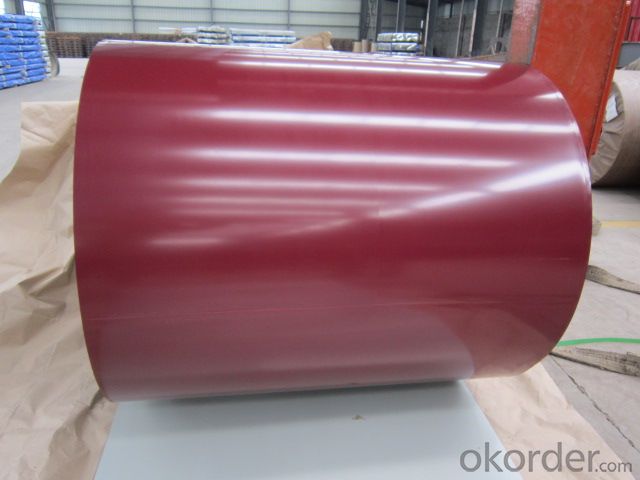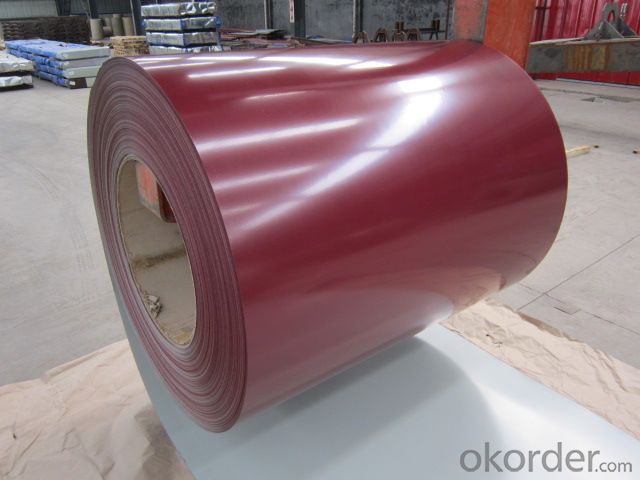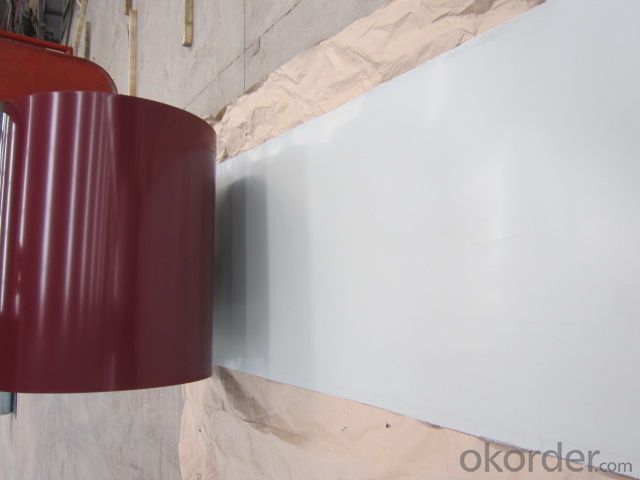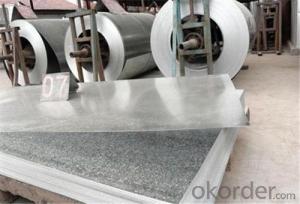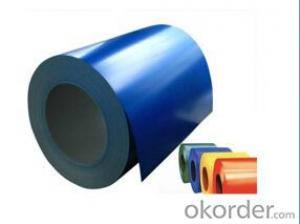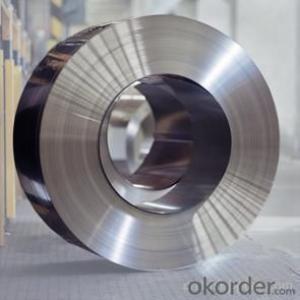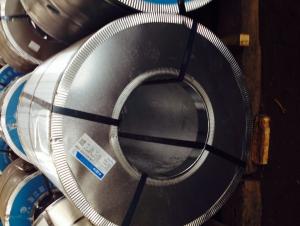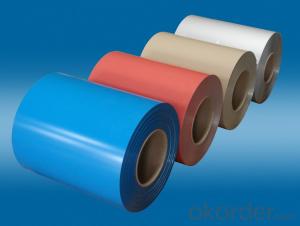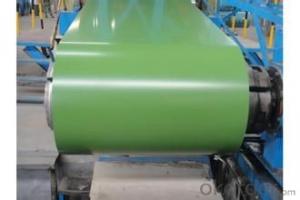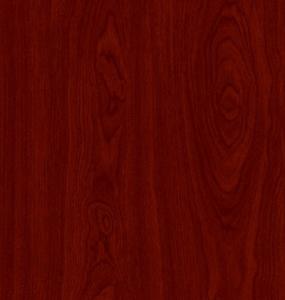Pre Painted Galvanised Steel Coil in Coil
- Loading Port:
- Shanghai
- Payment Terms:
- TT OR LC
- Min Order Qty:
- 25 m.t.
- Supply Capability:
- 10000 m.t./month
OKorder Service Pledge
OKorder Financial Service
You Might Also Like
Pre Painted Galvanised Steel Coil
Description:
Pre Painted Steel Coil is coated with organic layer, which provides higher anti-corrosion property and a longer lifespan than that of galvanized steel sheets.
The base metals for Pre Painted Steel Coil consist of cold rolled, HDG electro-galvanized and hot-dip alu-zinc coated steel. The finish coats of Pre Painted Steel Coil can be classified into groups as follows: polyester, silicon modified polyesters, polyvinylidene fluoride, high-durability polyester, etc.
The Pre Painted Steel Coil can also be classified into groups by their surface textures, namely regular prepainted sheets, embossed sheets and printed sheets.
Application:
Suitable for indoor or outdoor decoration, color lasting for at least 10 years for outdoor using, could for roll forming., conditioning, micro-wave oven, bread maker,solar water heater,condencing apparatus,Blackboard, white board,chalkboard, hidden cell blackboard,bulletin board,Central heating slice, lampshade, chifforobe, desk, bed, locker, bookshelf,garbage can, billboard, typewriter, instrument panel, weight sensor, photographic equipment,coffin, fence, Prepainted Galvanized Steel Coil
Product Specification:
Paint: PE or PVDF
Color pre painted steel in coil
Thickness: 0.3-0.8mm
Width: 914-1250mm
Inner Diameter: 508mm,610MM
Weight of Steel Coil: 3-8MT
Available Dipped Layer: 50-150g/m2
Coating Type: Al-Zn Alloy
Front Side Paint Thickness: 15-25μm
Back Side Paint Thickness: 5-10μm
Standard:JIS G3312,CGCC
FAQ:
1.How about the color of the Pre Painted Steel Coil
The color of the Pre Painted Steel Coil has a very wide selection, like orange, cream-colored, dark sky blue, sea blue, bright red, brick red, ivory white, porcelain blue.
2.Could you tell me the package for the Pre Painted Steel Coil?
Usually Standard export seaworthy package: waterproof paper+steel trip packed+wooden case seaworthy package
3. Can you produce the goods according to the customer’s requirements?
Yes, of course, it can be customized according to customers requirements.
- Q: Can steel coils be used in the production of agricultural equipment?
- Yes, steel coils can be used in the production of agricultural equipment. Steel is a commonly used material in the manufacturing of agricultural machinery such as tractors, plows, harvesters, and irrigation systems. Steel coils can be formed, cut, and shaped to create various components and structures required for these equipment. The strength, durability, and corrosion resistance of steel make it suitable for withstanding the harsh conditions and heavy workloads involved in agricultural operations.
- Q: What are the different methods of cutting steel coils?
- There are several methods of cutting steel coils, including shearing, slitting, laser cutting, and saw cutting.
- Q: Are steel pokemon weak against any attacks? If so, what types? (like water, grass, etc.)
- Thier weak aginst Fire type pokemon.
- Q: What is the process of uncoiling steel coils?
- The process of uncoiling steel coils involves unwinding the tightly wound steel coils using specialized equipment such as uncoiling machines or decoilers. These machines utilize hydraulic or mechanical systems to hold the coil securely while gradually releasing the tension on the coil. As the coil is released, it starts to unwind, with the steel strip gradually straightening out. This process allows for the easy feeding of the steel strip into further production processes such as cutting, stamping, or forming.
- Q: How do steel coils contribute to the agricultural machinery industry?
- Steel coils are an essential component in the manufacturing of agricultural machinery as they are used to create durable and robust parts such as frames, chassis, and components. The high strength and versatility of steel coils ensure that agricultural machinery can withstand harsh conditions and heavy usage, providing reliability and longevity to farmers and the industry as a whole.
- Q: What are the common problems faced during steel coil production?
- During the production of steel coils, several common issues may arise. One of the most frequently encountered problems is the breakage or damage of the coils. This can happen as a result of improper handling or transportation, leading to cracks or fractures. To minimize the risk of coil breakage, it is crucial to adhere to proper handling procedures. Another issue that often arises is coil slippage. This occurs when the coils are not securely stacked or stored, causing them to shift or slide. Coil slippage can cause damage to the coils and potentially lead to accidents or injuries. Therefore, it is essential to have adequate storage systems in place to prevent such slippage. Furthermore, corrosion is a prevalent problem in steel coil production. Corrosion can be caused by exposure to moisture, air, or other corrosive substances. It can result in the deterioration of the steel, reducing its strength and durability. To address this issue, it is necessary to implement effective corrosion prevention measures, such as proper coating or storage techniques. Coil quality issues are another challenge faced in steel coil production. These problems can include inconsistencies in thickness, width, or surface defects on the coils. Various factors, such as improper rolling processes, equipment malfunctions, or material defects, can contribute to these quality problems. Regular quality checks and inspections should be carried out to promptly identify and resolve any issues. Moreover, problems related to coil handling and loading may also arise during steel coil production. Improper lifting or loading techniques can lead to coil damage, resulting in deformations or even accidents. Proper training and education of employees on appropriate handling and loading procedures are crucial to prevent such problems. In conclusion, steel coil production can encounter various challenges, ranging from coil breakage and slippage to corrosion and quality issues. Implementing proper handling, storage, and quality control measures is indispensable in minimizing these problems and ensuring the production of high-quality steel coils.
- Q: What are the factors to consider when selecting a supplier for steel coils?
- When selecting a supplier for steel coils, there are several factors that need to be taken into account. Firstly, the reputation of the supplier in terms of providing high-quality steel coils is crucial. It is important for the steel coils to meet industry standards and have consistent quality to ensure the durability and performance of the final product. Secondly, the supplier should be reliable and able to consistently meet the demand for steel coils. They should have a proven track record of delivering on time and efficiently handling large orders. The cost of the steel coils is also a significant factor to consider. While competitive prices are important, it is equally important to ensure that the quality is not compromised. It is advisable to compare prices from multiple suppliers to find the best balance between cost and quality. It is also important to look for a supplier that offers a wide range of steel coil products. This will provide various options to choose from and ensure that the exact specifications and dimensions that meet the requirements are available. A supplier with technical expertise and experience in the steel industry can be valuable. They can provide advice and assistance in selecting the right steel coils for specific needs and help with any customization or special requirements. Considering the location and delivery capabilities of the supplier is also important. Choosing a supplier who is geographically closer to the facility can help reduce transportation costs and lead times. Lastly, good customer service is always preferable. The supplier should be responsive to inquiries, provide timely updates, and be willing to address any issues or concerns that may arise. By taking these factors into consideration, an informed decision can be made to choose a supplier that best meets the requirements for steel coils.
- Q: What are the common methods of inspecting steel coils for defects?
- The common methods of inspecting steel coils for defects include visual inspection, ultrasonic testing, magnetic particle inspection, and eddy current testing.
- Q: I read that contrary to popular belief, today's folded steel swords are only made that way for tradition and cosmetics. In the past steel was very impure and therefore had to be folded in order to make a good sword. Today's steel manufacturing provides very pure steel and so folding the metal only makes it look nicer, but does nothing to improve the function of the blade.What do you think of this?
- This Site Might Help You. RE: Does folding modern steel do anything to enhance a sword? I read that contrary to popular belief, today's folded steel swords are only made that way for tradition and cosmetics. In the past steel was very impure and therefore had to be folded in order to make a good sword. Today's steel manufacturing provides very pure steel and so folding the...
- Q: How are steel coils cut to size?
- Steel coils are cut to size using a process called slitting, where the coil is unwound and passed through a set of rotary knives that make longitudinal cuts. The width of the cuts can be adjusted to achieve the desired size, and the resulting strips are then rewound into smaller coils or flattened into sheets.
Send your message to us
Pre Painted Galvanised Steel Coil in Coil
- Loading Port:
- Shanghai
- Payment Terms:
- TT OR LC
- Min Order Qty:
- 25 m.t.
- Supply Capability:
- 10000 m.t./month
OKorder Service Pledge
OKorder Financial Service
Similar products
Hot products
Hot Searches
Related keywords



